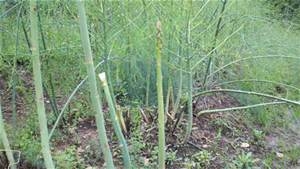
If you are patient and forgo harvesting tasty green spears the first two years after planting, a properly sited asparagus bed can pay off in bountiful spring harvests of asparagus for the next 12 to 15 years. Some well-tended asparagus beds still produce after 25 years.
Asparagus is a hardy perennial that adapts to a variety of temperatures. But it is happiest in a climate like ours, where winters are cool and the ground might freeze just an inch or two.
When you are looking around for the best place to plant asparagus, keep a few things in mind. The vegetable wants plenty of sun and good drainage. And because asparagus beds last a long time, put them where they will not be bothered.
Even if home-grown asparagus won't grace your table the first two seasons, the plants provide beauty and interest in your garden. Asparagus makes a beautiful screen with soft, ferny foliage and red berries. But it is tall and can shade other plants, so plan accordingly.
If you prepare your asparagus bed correctly, you will not be digging it again for a long time. Break up the soil 18 to 24 inches deep. Add organic matter to feed the plants and provide good drainage. Aged manure, bone meal, blood meal, wood ashes, compost, worm castings and leaf mold are all good choices.
Dig in these amendments before heading off to the nursery. Asparagus crowns do best when you get them into the ground and watered soon after purchase.
You can start asparagus from seed—more economical than buying crowns—but you will need to wait an additional year before harvest. That's why most gardeners plant one-year-old crowns. At the nursery, choose plump, grayish-brown crowns that look healthy. Remove any rotten or dried roots. Plant crowns 12 inches apart; measure and mark the planting spots before you head to the nursery.
To plant, dig a trench 18 to 24 inches wide and set that amended soil aside. Return 2 to 3 inches of the amended soil to the trench spreading it along the bottom of the bed. Gently spread the roots of each asparagus crown over the mound so the crowns are slightly above the roots. Cover the crowns with 2 to 3 inches of amended soil and firm it well. As the asparagus begins to grow, add more amended soil to the trench to cover the exposed crowns until the trench is filled. Water as needed if nature doesn't.
To maintain your asparagus bed, weed thoroughly in the spring. Pull weeds gently instead of hoeing to avoid damaging the fragile new growth underground.
Do not harvest the first year after planting. The second year, harvest only lightly. Newly planted asparagus grows long storage roots. These pencil-thin, fleshy roots store the carbohydrate synthesized from sunlight that the ferny foliage captures all summer long. The following spring, this energy pushes up through the earth in exuberant growth. It is an amazing thing to see fresh asparagus spears push toward the light, sometimes growing a foot a day.
When it is time to harvest, snap off 6- to 8-inch spears at or below the soil surface. The plants can get away from me, and I am not averse to using spears that are up to 18 inches tall. But the stalks still have to snap off to make it to my kitchen; if they don't, they aren't fresh. Harvest daily in season and use immediately, or refrigerate in a plastic bag for a few days. Asparagus freezes well and can be steamed, baked, braised, grilled and used in cold and hot soups. Pickled asparagus is wonderful for appetizers or Bloody Marys.
After the harvest, let the ferny foliage grow. Female plants set attractive red berries. When the ferns start to yellow and die, or if there is an early freeze, cut the foliage back to 2-inch stubs.
Some people have a reaction to eating asparagus; it's harmless but hard to ignore. We will not talk about that, however. You know who you are.
Workshop: The U. C. Master Gardeners of Napa County will host a workshop on “Drought-Tolerant and California Native Plants” on Saturday, October, 3, from 9 a.m. to 11 a.m., at Pope Valley Fire Station, 5880 Pope Valley Road, Pope Valley. Learn about drought-tolerant and native plants and discover the elements that help them thrive in our Mediterranean climate. Learn how to use them in your own garden to replace some of your thirsty ornamentals. You will also learn about irrigation modifications to make your water use more efficient and effective.ONLINE REGISTRATION
This is a free workshop but pre-registration is requested. A minimum of 10 attendees is required or the workshop will be canceled.
Master Gardeners are volunteers who help the University of California reach the gardening public with home gardening information. U. C. Master Gardeners of Napa County ( http://ucanr.org/ucmgnapa/) are available to answer gardening questions in person or by phone, Monday, Wednesday and Friday, 9 a.m. to Noon, at the U. C. Cooperative Extension office, 1710 Soscol Avenue, Suite 4, Napa, 707-253-4143, or from outside City of Napa toll-free at 877-279-3065. Or e-mail your garden questions by following the guidelines on our web site. Click on Napa, then on Have Garden Questions? Find us on Facebook under UC Master Gardeners of Napa County.